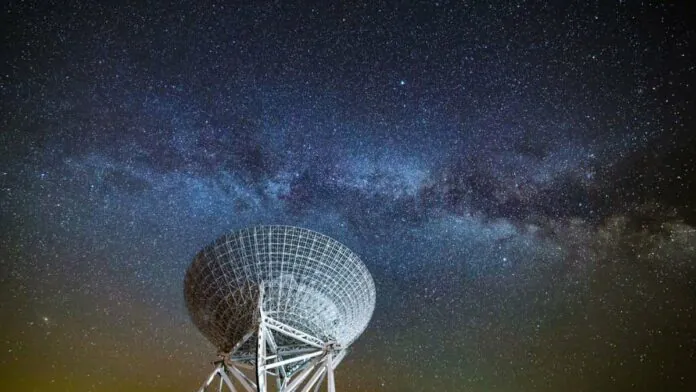© ROOT-NATION.com - Use of content is permitted with a backlink.
During observations on the radio continuum of a spiral galaxy known as NGC 2082, Australian astronomers discovered a mysterious bright and compact radio source, designated J054149.24-641813.7. The origin and nature of this source are unknown and require further study.
In general, radio sources are various objects in the universe that emit a relatively large number of radio waves. The strongest sources of such emissions are pulsars, some nebulae, quasars, and radio galaxies.
Astronomers at the University of Western Sydney in Australia have announced the discovery of a new radio source, the true nature of which is still unclear. While observing NGC 2082 with the Australian Square Kilometer Array Pathfinder (ASKAP), Australia Telescope Compact Array (ATCA), and Parkes radio telescope, they discovered a powerful point radio source located 20 angular seconds from the center of the galaxy. NGC 2082 is a spiral galaxy of the G-type in the constellation of Goldfish, located about 60 million light-years from Earth and has a diameter of about 33 thousand light-years.

The study showed that the radio illuminance of J054149.24–641813.7 at 888 MHz is at a level of 129 EW/Hz and has a flat radio spectral index (about 0.02). This, according to astronomers, contradicts the scenario in which J054149.24-641813.7 could be a supernova remnant (SNR) or a pulsar, suggesting that the source may be of thermal origin.
The researchers noted that the compactness of J054149.24–641813.7 and its location on the outskirts of NGC 2082 resemble some fast radio bursts (FRBs). However, the results show that J054149.24-641813.7 is probably not bright enough to be a permanent radio source with a built-in FRB precursor.
Astronomers have concluded that the most likely possibility is that J054149.24-641813.7 is an extragalactic background source, such as a quasi-stellar object, a radio galaxy, or an active galactic nucleus. They added that the flat spectral index together with slightly weak polarization at 5500 and 9000 MHz confirm this hypothesis. However, there are currently no high-resolution absorptions of neutral atomic hydrogen for NGC 2082 that could support this assumption.
“We find that the probability of finding such a source behind NGC 2082 is P = 1.2 percent, and conclude that the most likely origin for J054149.24–641813.7 is a background quasar or radio galaxy,” the authors of the paper explained.
You can also help Ukraine fight with Russian occupants via Savelife or via an official page of the National Bank of Ukraine.
Read also:
- Hubble photographed an unusual pair of spiral galaxies
- An unusual neutron star discovered in the star graveyard


